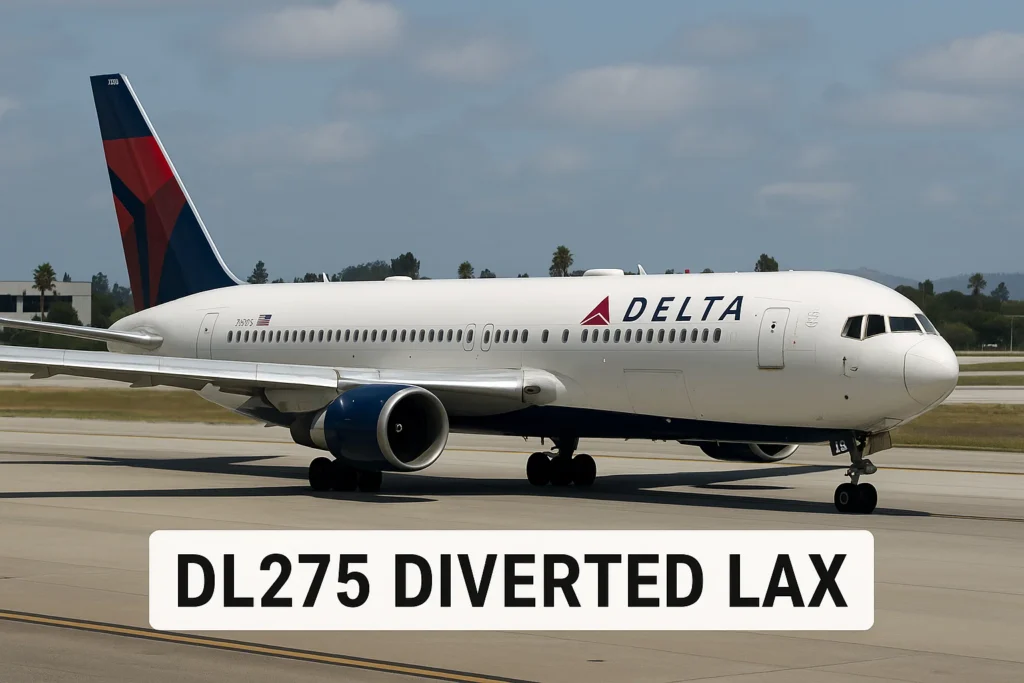Flying can be an exciting experience, but it also comes with its challenges. Sometimes, unforeseen events such as weather conditions, technical issues, or medical emergencies can cause disruptions. One such incident occurred with Delta Flight DL275, which was diverted to Los Angeles International Airport (LAX) unexpectedly. For passengers, it was a moment of uncertainty and confusion. In this article, we will explore what happened, the reasons behind the diversion, and how passengers were impacted.
What Happened on Delta Flight DL275?
Delta Flight DL275, initially scheduled to fly from New York’s John F. Kennedy International Airport (JFK) to Tokyo Narita (NRT), was diverted to Los Angeles International Airport (LAX) due to a technical issue that required immediate attention. The flight, which was supposed to be a long-haul international journey, had to make a sudden diversion after reaching a certain point over the Pacific Ocean.
Although the specific details of the technical problem have not been disclosed, such diversions are often necessary for safety reasons. Passengers were informed by the flight crew that the aircraft was not fit to continue its journey and that LAX would be the most suitable airport for emergency landing and further assessment.
Why Do Flights Get Diverted?
Flight diversions are not uncommon, and they occur for various reasons, such as:
- Technical Issues: This is the most common cause of a diversion. If a plane experiences a mechanical malfunction mid-flight, the safety of passengers is prioritized, and the aircraft is rerouted to the nearest airport.
- Weather Conditions: Severe weather, such as thunderstorms, fog, or high winds, can make it dangerous to land at the scheduled destination, leading pilots to make an unscheduled diversion to a safer location.
- Medical Emergencies: If a passenger onboard suffers a medical emergency, the flight crew may opt to divert the plane to the nearest airport to ensure that the individual receives immediate medical care.
- Fuel Issues: In rare cases, fuel miscalculations or unexpected headwinds can require a diversion to ensure the aircraft has enough fuel to safely land.
Impact on Passengers
For passengers aboard Delta Flight DL275, the diversion to LAX was unexpected and caused significant inconvenience. Here’s how passengers were affected:
- Delayed Arrival: Passengers who were headed to Tokyo were understandably frustrated by the delay. While Delta Airlines made arrangements for their safety, including providing accommodations, food, and transport to hotels, the late-night diversion caused disruptions to schedules.
- Rebooking and Compensation: Delta Airlines is known for offering compensation or rebooking options to passengers whose flights have been diverted or delayed due to technical issues. Passengers on DL275 were likely offered rebooking on another flight to Tokyo or assistance in obtaining a refund. Delta’s commitment to customer service is crucial in maintaining passenger satisfaction in these situations. For more information on compensation policies, you can visit Delta’s official customer service page.
- Communication with Passengers: One of the most critical aspects of a diversion is how the airline communicates with passengers. Delta Airlines took appropriate steps by keeping passengers informed about the situation, offering assistance, and ensuring that everyone was well taken care of.
How Often Do Flights Get Diverted?
While diversions are not a daily occurrence, they happen more frequently than many travelers realize. According to the Federal Aviation Administration (FAA), the rate of flight diversions in the U.S. is relatively low compared to the number of flights. However, when they do happen, it’s typically for safety-related reasons, ensuring that the passengers are not at risk.
In fact, diversions are often a sign of airlines prioritizing safety over convenience. As aircraft technology and flight tracking systems improve, pilots and flight crews are increasingly equipped with the tools to assess and react quickly to any safety concerns.
The Role of LAX in Emergency Landings
LAX is one of the busiest airports in the world, serving as a major hub for international flights. It also plays a critical role in emergency landings and diversions. The airport is equipped with the necessary infrastructure and medical facilities to handle unexpected events, making it an ideal location for emergency landings.
In cases like Delta Flight DL275, LAX offers immediate services for passengers, including medical support, rebooking assistance, and coordination with ground services to ensure smooth operations during an emergency. Learn more about how LAX manages emergency landings and diversions by visiting the official LAX website.
Conclusion
Delta Flight DL275’s diversion to LAX was a reminder of the unpredictability of air travel and the importance of airline safety protocols. While the diversion caused inconvenience for passengers, Delta Airlines’ quick response ensured that everyone remained safe and received the necessary support. Flight diversions may be rare, but they are essential to ensure the safety of passengers, crew, and aircraft.
By understanding the reasons behind such diversions and how airlines like Delta manage them, travelers can have greater confidence in the safety measures taken during flights. Always be prepared for the unexpected when traveling, and know that airlines have your best interests at heart.
